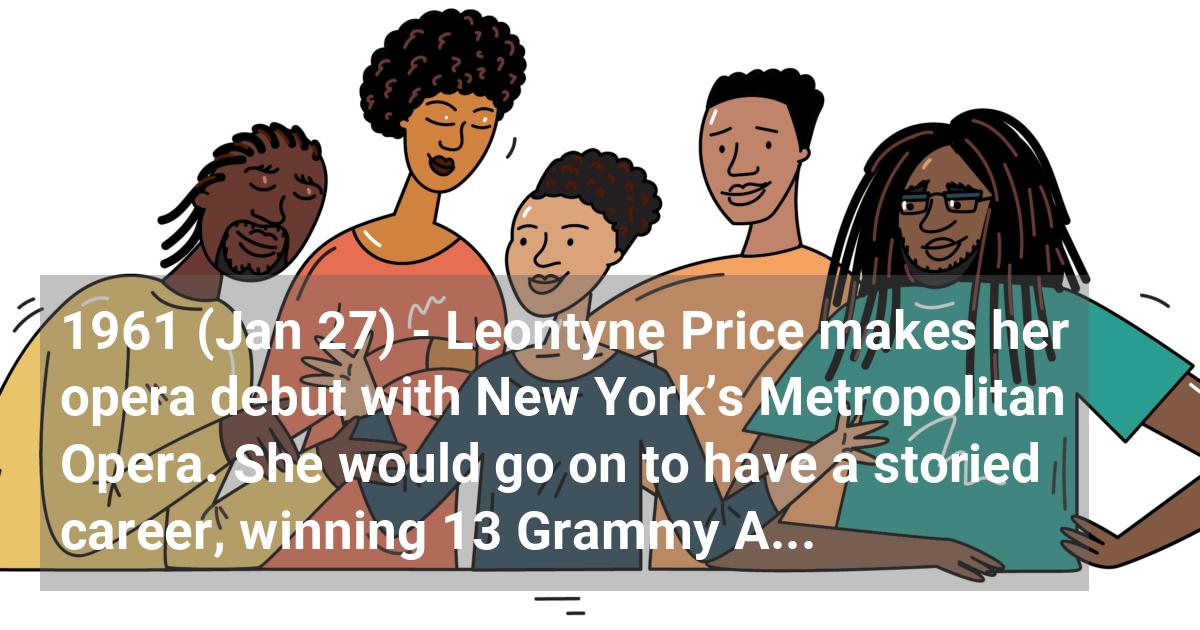Home / Full timeline / Leontyne Price makes her opera debut with New York’s Metropolitan Opera. She would go on to have a storied career, winning 13 Grammy Awards and receiving the Presidential Medal of Freedom.
 Leontyne Price makes her opera debut with New York’s Metropolitan Opera. She would go on to have a storied career, winning 13 Grammy Awards and receiving the Presidential Medal of Freedom.
Leontyne Price makes her opera debut with New York’s Metropolitan Opera. She would go on to have a storied career, winning 13 Grammy Awards and receiving the Presidential Medal of Freedom.
1961 (Jan 27)
Leontyne Price debuted with New York's Metropolitan Opera in Il Trovatore, and an unprecedented forty-two-minute standing ovation followed her performance. Price soon established herself as "the Stradivarius of singers," and when the New York company moved to its new quarters at Lincoln Center, director Rudolf Bing honored Price with an invitation to open the new opera house in the world premier of Samuel Barber's Antony and Cleopatra. One season after her debut, she opened in the title role of Puccini's The Girl of the Golden West and launched a prolific recording career en route to becoming one of the world's leading sopranos and the first Black singer to gain international stardom in opera. By 1969, Price had appeared in more than one hundred Metropolitan Opera productions. Mary Violet Leontyne Price was born in Jackson, Mississippi, on February 10, 1927. At the age of nine she attended a concert by Black American vocalist Marian Anderson and decided to devote her life to singing. After receiving her bachelor's degree in 1949, Price was awarded a four-year, full-tuition scholarship at the Juilliard School of Music in New York, where she studied voice with Florence Page Kimball. After a two-year jaunt in a revival of George Gershwin's Porgy and Bess, the diva made her concert debut at New York's Town Hall, where she impressed audiences with her facility with modern compositions. Numerous NBC telecasts followed. The first telecast, Puccini's Tosca, distinguished Price as the first Black singer to perform opera on television. In 1957, conductor Kurt Herbert Adler, who had seen Price perform in Tosca, invited her to sing the role of Madame Lidoine in Dialogues of the Carmelites with the San Francisco Opera. That same year, the San Francisco Opera's lead soprano in Aida had an emergency appendectomy, and Adler asked the Mississippi soprano if she knew the opera. Price, whose perfect Verdi voice eventually came to define the role of Aida, recounted: "That was being in the right place at the right time." Price has won thirteen Grammy Awards, and in 1965 she received the Presidential Medal of Freedom, the nation's highest civilian award. In 1980, she was awarded the Kennedy Center Honors for Lifetime Achievement in the Arts, and five years later she received the first National Medal of the Arts. Price performed at the White House in 1978 and 1982, and she opened the convention of the Daughters of the American Revolution (DAR) in Constitution Hall with a concert honoring Marian Anderson, who, in 1939, had been barred from appearing in Constitution Hall by the DAR because of her race.
References:
- • Hornsby, Alton. Chronology of African-American History: Significant Events and People from 1619 to the Present. Detroit: Gale Research, 1995.
